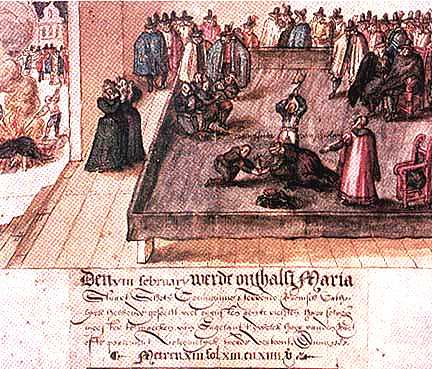

Mary, Queen of Scots Home Page
Mary was led up the three steps to the stage and from there listened unperturbed to the commission for her execution. It wasn't until the Protestant Dean from Peterborough proposed to say her prayers according to Protestant rights that she expressed her disapproval. The Dean nevertheless proceeded while Mary, kneeling, read out loud from her Latin Prayer book, and then in English. The executioners as customary, then asked for her pardon to which she replied: "I forgive you with all my heart, for now I hope you shall make an end of all my troubles". They proceeded to help her undress assisted by Jane Kennedy and Elizabeth Curle, and to divest her of her Agnus Dei and Rosary. Mary was now stripped to her red petticoat with red satin bodice trimmed with lace and a pair of red sleeves. Red, the colour of martyrdom in the Catholic church.
After bidding her servants not to cry and to pray for her, Jane Kennedy bound her eyes with a white cloth embroidered in gold, chosen by Mary the night before. Mary now stood alone on the stage and positioned her own chin on the wooden execution block. "Into thy hands O Lord I commend my spirit" were her last words before the first stroke of the axe.
The first blow missed the neck and cut into the back of the head. Mary was heard to whisper "Sweet Jesus".
The second blow almost severed the head.
The third blow completely cut through the remaining sinew.
As the executioner then picked up the head and held it up in the air to show the audience, the wig slipped off and the head rolled to the floor. Mary's hair was almost entirely grey from her long imprisonment. Every relic was burned and every drop of blood washed away. Her little Skye terrier which had managed to hide under her skirts and would not leave his dead mistress's side was also washed but refused thereafter to be fed.
Mary's body was then subjected to further humiliations. Her heart and organs were buried deep within the Castle of Fotheringhay but the exact spot was never revealed. The body was then embalmed and incarcerated in a heavy lead coffin which remained unburied in the Castle until 30th July 1587, where it was taken at the dead of night for fear of public protest, to Peterborough Cathedral.
![]()